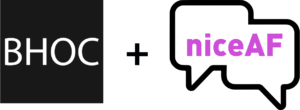It’s a mess out there. If you’ve been on a dating app recently, you probably know what I’m talking about – the deluge of unrequested photos, trying to string along a conversation from one-liner responses, the made-and-broken plans to meet up. Then, of course, we have the toxicity. People ghosting. People, under the guise of near anonymity, saying racist or stigmatizing things that they might not in the light of day. The constant judgement of one’s face or body as good, or good enough, or not quite either.
 What exactly, though, does any of this have to do with our work at NMAC? More than we thought, it turns out. According to the researchers who penned NiceAF, a recent report sponsored by Building Healthy Online Communities (BHOC), consistent negative experiences on dating/hookup apps can actually increase a person’s chances of acquiring HIV. From the report: “Yale University researchers, John Pachankis and Charles Burton, found that for some gay and bi men, being repeatedly rejected by other gay and bi men online is associated with greater risk for HIV and symptoms of depression and anxiety.”
What exactly, though, does any of this have to do with our work at NMAC? More than we thought, it turns out. According to the researchers who penned NiceAF, a recent report sponsored by Building Healthy Online Communities (BHOC), consistent negative experiences on dating/hookup apps can actually increase a person’s chances of acquiring HIV. From the report: “Yale University researchers, John Pachankis and Charles Burton, found that for some gay and bi men, being repeatedly rejected by other gay and bi men online is associated with greater risk for HIV and symptoms of depression and anxiety.”
In NMAC’s Treatment division, we often talk about identifying gaps in knowledge that need to be filled. Right now, we have the tools at hand to end this epidemic: effective HIV treatments, PrEP, PEP, and condoms. In this movement, we need to do a better job of understanding how to better empower people, especially queer people of color, to utilize these tools according to their own needs. Treatment and adherence education is a big part of that, as is advocating for structural change at every level of power.
And yet, there’s still another factor to address, a deep and nebulous one, before we can finally end the epidemic. That, of course, is figuring out how to lessen the levels of shame and stigma in queer communities, especially around HIV. On one level, the fact that there is still so much shame and stigma is understandable, given all the ways that the white supremacist heteropatriarchy signals to queer folks of color that this world was not made for us.
We would be remiss to ignore, however, that part of this shame and stigma is perpetuated by our own communities. Perhaps researchers are picking up on something that folks have intuitively felt for a long time: many of us expect this kind of stigma from straight people, but the effects can be deleterious after consistently hearing it from those we might be counting on.
 At the root of our work in Treatment is really thinking about the ways that we, particularly queer folks of color, relate to one another and to tailor adherence and prevention education programming to those lived realities. One thing that we are learning more and more about, thanks in large part to the work of activists/researchers (like those at BHOC), is that the stresses queer communities of color experience are complex, and our interventions need to be nimble enough to respond. It’s one of the reasons we are so passionate about our Gay Men of Color Fellowship, and the innovative work they do to share life-changing information with their social networks in a culturally competent way. It’s this kind of work, an assurance that there is a supportive community out here, that motivates us each day.
At the root of our work in Treatment is really thinking about the ways that we, particularly queer folks of color, relate to one another and to tailor adherence and prevention education programming to those lived realities. One thing that we are learning more and more about, thanks in large part to the work of activists/researchers (like those at BHOC), is that the stresses queer communities of color experience are complex, and our interventions need to be nimble enough to respond. It’s one of the reasons we are so passionate about our Gay Men of Color Fellowship, and the innovative work they do to share life-changing information with their social networks in a culturally competent way. It’s this kind of work, an assurance that there is a supportive community out here, that motivates us each day.
Jonathan Ayala
Program Coordinator – Treatment Division